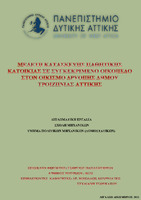| dc.contributor.advisor | Kourniatis, Nikolaos | |
| dc.contributor.advisor | Τσουκάτου, Στέλλα | |
| dc.contributor.author | Παπασωτηρίου, Γεώργιος | |
| dc.date.accessioned | 2022-05-24T13:06:05Z | |
| dc.date.available | 2022-05-24T13:06:05Z | |
| dc.date.issued | 2022-02-17 | |
| dc.identifier.uri | https://polynoe.lib.uniwa.gr/xmlui/handle/11400/2284 | |
| dc.identifier.uri | http://dx.doi.org/10.26265/polynoe-2135 | |
| dc.description.abstract | Η παρούσα διπλωματική εργασία προσπαθεί να εισάγει το κόσμο στην έννοια του Παθητικού Κτιρίου, τόσο στο θεωρητικό κομμάτι όσο και στο πρακτικό, με τη μελέτη κατασκευής μιας παθητικής κατοικίας. Πρώτα απ΄ όλα, στην εισαγωγή, εξιστορείται η χρονική εξέλιξη του ΠΚ από την εμφάνισή του πίσω στον Μεσαίωνα μέχρι το κτίριο του σήμερα. Επισημαίνονται, σε γενικές γραμμές, ο τρόπος λειτουργίας του με ειδικότερα τις πέντε βασικές αρχές που το καθιστούν ως πρότυπο κτιρίου και τα θερμικά κέρδη που προσφέρει στους ενοίκους. Αφορά αποκλειστικά σε οφέλη που σχετίζονται με την εξοικονόμηση ενέργειας, με επεμβάσεις κυρίως σε θέματα ψύξης και θέρμανσης. Ύστερα, παρουσιάζονται μερικά παραδείγματα Παθητικών Κτιρίων, από την Ελλάδα και το εξωτερικό, μέσα από λεπτομερείς επισημάνσεις σε διάφορους τύπους κτιρίων, με τα υλικά κατασκευής, τα μηχανικά συστήματα και τις τιμές του λογισμικού PHPP (απόδοση και απαιτήσεις ενέργειας για το ΠΚ) να είναι στο επίκεντρο. Παράλληλα, γίνεται ειδική αναφορά στο υπολογιστικό μέρος που είναι απαραίτητο για το σχεδιασμό του ΠΚ, με την συνεργασία των λογισμικών PHPP και designPH να έχουν πρωταρχικό ρόλο, λαμβάνοντας υπόψη διάφορους παραμέτρους, όπως είναι τα κλιματικά δεδομένα.
Επιπροσθέτως, δεν είναι όλα τα Παθητικά Κτίρια πιστοποιημένα, και γι΄ αυτό το λόγο υπάρχουν κάποια κριτήρια που στοχεύουν στην πιστοποίηση ενός κτιρίου ως παθητικό, χωρίς βέβαια να πρέπει να τηρηθούν όλα. Επίσης, στη συνέχεια τονίζεται ο
τρόπος κατασκευής του ΠΚ με αναφορά στο ίδιο το κτίριο και τα στοιχεία που το περικλείουν, με πιο σημαντικά τα κουφώματα, πιστοποιημένα ή μη, και την μόνωση που έχει τον πρώτο λόγο στην αποφυγή των θερμογεφυρών. Τέλος, στο πρακτικό μέρος, κατασκευάζεται μία παθητική κατοικία με ιδιαιτέρως αναλυτικό τρόπο σε όλους τους τομείς της, με επεξήγηση των αποτελεσμάτων κατά τη διάρκεια υλοποίησή της καθώς και υπολογισμό του κόστους. | el |
| dc.format.extent | 142 | el |
| dc.language.iso | el | el |
| dc.publisher | Πανεπιστήμιο Δυτικής Αττικής | el |
| dc.rights | Αναφορά Δημιουργού - Μη Εμπορική Χρήση - Παρόμοια Διανομή 4.0 Διεθνές | * |
| dc.rights | Attribution-NonCommercial-NoDerivatives 4.0 Διεθνές | * |
| dc.rights.uri | http://creativecommons.org/licenses/by-nc-nd/4.0/ | * |
| dc.subject | Παθητικό κτίριο | el |
| dc.subject | Ελληνικό Ινστιτούτο Παθητικού Κτιρίου | el |
| dc.subject | ΕΙΠΑΚ | el |
| dc.subject | Μόνωση | el |
| dc.subject | Έλεγχος αεροστεγανότητας | el |
| dc.subject | Κοστολόγηση | el |
| dc.subject | Κοστολόγηση έργου | el |
| dc.subject | Κουφώματα | el |
| dc.subject | Passive house | el |
| dc.subject | Passive House Planning Package | el |
| dc.subject | PHPP | el |
| dc.subject | DesignPH | el |
| dc.subject | Blower door test | el |
| dc.subject | AutoCAD | el |
| dc.title | Μελέτη κατασκευής παθητικής κατοικίας σε συγκεκριμένο οικόπεδο στον οικισμό Δρυόπης Δήμου Τροιζηνίας - Αττικής | el |
| dc.title.alternative | Study of the construction of a passive house on a specific plot in the settlement of Driopi Municipality of Trizinia - Attica | el |
| dc.type | Διπλωματική εργασία | el |
| dc.contributor.committee | Γεωργακοπούλου, Φωτεινή | |
| dc.contributor.committee | Σιπόπουλος, Γεώργιος | |
| dc.contributor.faculty | Σχολή Μηχανικών | el |
| dc.contributor.department | Τμήμα Πολιτικών Μηχανικών | el |
| dc.description.abstracttranslated | The present thesis tries to introduce the world to the concept of the Passive House, both in the theoretical part and in the practical part, with the study of the construction of a Passive House. First of all, in the introduction, the time evolution of the PH from its appearance back in the Middle Ages to the building of today is narrated. It is pointed out, in general, the way it operates with, in particular the five basic principles that make it a model building and the thermal gains it offers to the tenants. It concerns exclusively the benefits that are related to the energy saving, with interventions mainly in matters of cooling and heating. Then, some examples of Passive Houses are presented, from Greece and abroad, through detailed markings on various types of buildings with the construction materials, mechanical systems and prices of PHPP software (performance and energy requirements for PH) in focus. At the same time, special reference is made to the computer part that is necessary for the design of PH, with the cooperation of PHPP and designPH software to have a primary role, taking into account various parameters, such as climate data. In addition, not all Passive Houses are certified, and for this reason there are some criteria that aim to certify a building as passive, without of course having to comply with everything. Also, the way of construction of PH is emphasized with reference to the building itself and the elements that enclose it, with the most important, the frames, certified or not, and the insulation that has the first word in the avoidance of thermal bridges. Finally, in the practical part, a Passive House is constructed in a very detailed way in all its areas, by explaining the results during its implementation as well as calculating the cost. | el |


